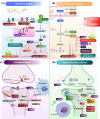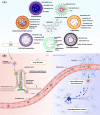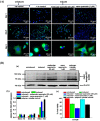Expanding Arsenal against Neurodegenerative Diseases Using Quercetin Based Nanoformulations: Breakthroughs and Bottlenecks
- PMID: 35950245
- PMCID: PMC10472810
- DOI: 10.2174/1570159X20666220810105421
Expanding Arsenal against Neurodegenerative Diseases Using Quercetin Based Nanoformulations: Breakthroughs and Bottlenecks
Abstract
Quercetin (Qu), a dietary flavonoid, is obtained from many fruits and vegetables such as coriander, broccoli, capers, asparagus, onion, figs, radish leaves, cranberry, walnuts, and citrus fruits. It has proven its role as a nutraceutical owing to numerous pharmacological effects against various diseases in preclinical studies. Despite these facts, Qu and its nanoparticles are less explored in clinical research as a nutraceutical. The present review covers various neuroprotective actions of Qu against various neurodegenerative diseases (NDs) such as Alzheimer's, Parkinson's, Huntington's, and Amyotrophic lateral sclerosis. A literature search was conducted to systematically review the various mechanistic pathways through which Qu elicits its neuroprotective actions and the challenges associated with raw Qu that compromise therapeutic efficacy. The nanoformulations developed to enhance Qu's therapeutic efficacy are also covered. Various ongoing/completed clinical trials related to Qu in treating various diseases, including NDs, are also tabulated. Despite these many successes, the exploration of research on Qu-loaded nanoformulations is limited mostly to preclinical studies, probably due to poor drug loading and stability of the formulation, time-consuming steps involved in the formulation, and their poor scale-up capacity. Hence, future efforts are required in this area to reach Qu nanoformulations to the clinical level.
Keywords: Alzheimer’s disease; Quercetin; antioxidant; neurodegenerative disease; neuroinflammation; novel drug delivery systems.
Copyright© Bentham Science Publishers; For any queries, please email at epub@benthamscience.net.
Conflict of interest statement
The authors declare no conflict of interest, financial or otherwise.
Figures






Similar articles
-
Targeting signaling pathways in neurodegenerative diseases: Quercetin's cellular and molecular mechanisms for neuroprotection.Animal Model Exp Med. 2025 May;8(5):798-818. doi: 10.1002/ame2.12551. Epub 2025 Jan 22. Animal Model Exp Med. 2025. PMID: 39843406 Free PMC article. Review.
-
Synthesis of Quercetin-Loaded Silver Nanoparticles and Assessing Their Anti-Bacterial Potential.Micromachines (Basel). 2023 Nov 25;14(12):2154. doi: 10.3390/mi14122154. Micromachines (Basel). 2023. PMID: 38138323 Free PMC article.
-
Application of Nanoparticles for Efficient Delivery of Quercetin in Cancer Cells.Curr Med Chem. 2024;31(9):1107-1141. doi: 10.2174/0929867330666230301121611. Curr Med Chem. 2024. PMID: 36856173 Review.
-
Neuroprotective effect of quercetin and nano-quercetin against cyclophosphamide-induced oxidative stress in the rat brain: Role of Nrf2/ HO-1/Keap-1 signaling pathway.Neurotoxicology. 2023 Sep;98:16-28. doi: 10.1016/j.neuro.2023.06.008. Epub 2023 Jul 6. Neurotoxicology. 2023. PMID: 37419146
-
Innovative delivery strategies for quercetin: A comprehensive review of advances and challenges.Compr Rev Food Sci Food Saf. 2025 May;24(3):e70146. doi: 10.1111/1541-4337.70146. Compr Rev Food Sci Food Saf. 2025. PMID: 40331705 Review.
Cited by
-
Neuroprotective Role of Phytoconstituents-based Nanoemulsion for the Treatment of Alzheimer's Disease.Curr Top Med Chem. 2024;24(19):1683-1698. doi: 10.2174/0115680266296001240327090111. Curr Top Med Chem. 2024. PMID: 38676489 Review.
-
Clinical Insights on Caloric Restriction Mimetics for Mitigating Brain Aging and Related Neurodegeneration.Cell Mol Neurobiol. 2024 Oct 16;44(1):67. doi: 10.1007/s10571-024-01493-2. Cell Mol Neurobiol. 2024. PMID: 39412683 Free PMC article. Review.
-
Targeting signaling pathways in neurodegenerative diseases: Quercetin's cellular and molecular mechanisms for neuroprotection.Animal Model Exp Med. 2025 May;8(5):798-818. doi: 10.1002/ame2.12551. Epub 2025 Jan 22. Animal Model Exp Med. 2025. PMID: 39843406 Free PMC article. Review.
-
Plant-based flavonoids and their nanoparticles: Latest arsenal against Alzheimer's disease.Drug Deliv Transl Res. 2025 Jun 30. doi: 10.1007/s13346-025-01906-9. Online ahead of print. Drug Deliv Transl Res. 2025. PMID: 40587047 Review.
-
Nano-mediated Management of Metal Toxicity-induced Neurodegeneration: A Critical Review.Mol Neurobiol. 2025 Jul;62(7):8400-8419. doi: 10.1007/s12035-025-04782-z. Epub 2025 Feb 25. Mol Neurobiol. 2025. PMID: 39994160 Review.
References
Publication types
MeSH terms
Substances
LinkOut - more resources
Full Text Sources
Medical

